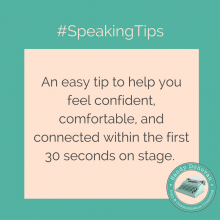How to make BFFs with your live audience
By Sandy

The best keynotes are personal.
A great way to form a personal connection with your audience is to talk right to them. On a personal level, outside of your speech.
But, you still want to stay focused on your content. How do you balance this?
In this post, I’ll show you my trick for connecting with the audience during the first 30 seconds that you’re on stage – I call it the Lead in Question.
Connect with your audience during the first 30 seconds of your keynote
The lead in question is a quick question that seemingly has nothing to do with your speech. It sounds personal. It quickly puts your audience at ease so that you can casually start your speech as if it were a conversation, not a lecture.
I started using the lead in question while I was teaching public speaking at a community college. I found that the audience, college students, were exhausted after sitting through a bunch of classes and weren’t looking forward to another lecture (probably what some of your conference attendees will feel if you’re not speaking during the first day and the first round).
So, instead of jumping right in with facts and figures, I began opening with a seemingly unrelated question.
Usually, the question was something they could all relate to and something that could easily lead into my opening story.
Here’s an example:
Ahhhh Monday. I had a long weekend. Not quite ready for the week – what about you all?
Not directly related to my lecture, but they would drop their guard for a moment. They could respond. About something personal, not about class or tests or homework. And this will work the same for you –it gives the audience a chance to interact with you on a personal, not professional, level – even if just for a moment.
2. The transition
Now that you’ve asked the lead in question, you may or may not get a huge response. Depending on what you ask, you might just get smiles. A head nod. Or maybe a few people will shout something back. Either way, it doesn’t matter. Plan to transition into your opening story.
I keep it simple. My transition statement is usually something like, “That reminds me…” Or, “I was thinking about that this morning and I remembered…” Simple. Just a transition that opens it up to your opening story. Here’s an example.
Ahhhh Monday. I had a long weekend. Not quite ready for the week – what about you all? Yeah, I figured. I was feeling overwhelmed this morning and it reminded me of this funny story actually. It happened about a year ago. I was with my son….
And then I go into the story, which is now strongly connected to the speech topic.
3. The benefit
If used correctly, your lead in question will get your audience to lower their guard and easily listen to your story – without feeling like they’re in learning or lecture mode. They’ll be absorbed in your story, and this will help them to feel a connection to you – because now they’re involved in a conversation – not a one-way communication where you are just speaking at them.
But, the lead in question does something else, too. It helps you, the speaker, ease into a speech in a very natural and conversational way. And this can greatly help you feel comfortable and act like yourself on stage, which will help you even more as you try to form a connection with your audience. It’s really a win-win.
Your turn – I want to hear, how do you start a speech? What tricks do you use to feel more comfortable or to connect with your audience? Let me know in the comments below.